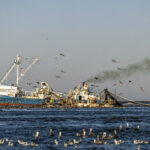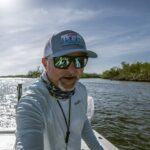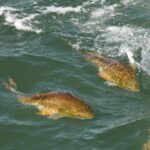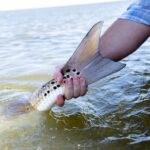
Gulf Menhaden Reduction Fishery: Bycatch Research & Useless Buffer Zones
Do you remember your driver’s test? How nervous were you when the instructor pulled out
Feature Photo: A false albacore being tagged off the coast of Massachusetts. 40% of these tagged fish swam to North Carolina waters in the following weeks. Photo Credit: Rex Messing | SIMMS Fishing
Basic guardrail management has been proposed for the false albacore fishery in North Carolina. Rule 15A NCAC 03M .0523 is proposed for adoption as transcribed below. This blog breaks down the basics of the proposed rule, the opportunities it presents and how you can use your voice to support the future of your fisheries.
WHAT DOES THE RULE SAY?
15A NCAC 03M .0523 FALSE ALBACORE
(a) If the level of landings of false albacore in a calendar year exceeds 200 percent of the five-year average of North Carolina recreational and commercial landings combined from 2018-2022, the Fisheries Director shall issue a proclamation as set forth in Paragraph (b) of this Rule.
(b) In accordance with Paragraph (a) of this Rule and after prior consent of the Marine Fisheries Commission, the Fisheries Director shall, by proclamation, impose the following requirements on the taking of false albacore:
(1) for recreational purposes, specify a bag limit not to exceed 10 fish per person per day, not to exceed 30 fish per vessel per day; and
(2) for a commercial fishing operation, specify a trip limit not to exceed 3,500 pounds in any one day or trip, whichever is more restrictive.
(c) A proclamation issued in accordance with Paragraphs (a) and (b) of this Rule shall become effective January 1 of the year following the year when the determination is made that a proclamation shall be issued. The proclamation shall expire when the level of landings falls below the landings level in Paragraph (a) of this Rule in a subsequent calendar year and after prior consent of the Marine Fisheries Commission.
WHAT DOES THAT MEAN?
In simplest terms, the rule established basic guardrails for false albacore if the state finds a significant increase in landings compared to a five-year average of landings. If landings exceed 200% of this five-year average for landings (2018-2022), the following regulations will be enacted:
A 30 fish maximum limit on recreational boats or 10 fish per person (if less than 3 people on board)
A 3500lb trip limit for commercial boats.
HOW IS THIS A WIN FOR ALBIES?
This sets a benchmark for the rest of the coast for managing false albacore. There are no known commercial or recreational regulations to directly manage the species in state or federal waters. Several states in the Northeast are watching this very closely and are poised to follow the lead of North Carolina.
Commercial and recreational landings have increased in the last ten years. In North Carolina, over 50% of commercial trips land less than 50 pounds a day, with trips exceeding 500 pounds accounting for only 3% of total landings. An average of 319,000 pounds of albies are landed in North Carolina across all sectors in a year. North Carolina makes up a small percentage of recreational landings, but North Carolina commercial landings are substantial in relation to coastwide commercial landings.
Positive action at this meeting would build a framework for future action in other states.
WHAT DOES THE SCIENCE SAY?

All indications from preliminary science show this is a connected coastal stock. What we do in North Carolina impacts the entire coast. 40% of the false albacore tagged in Nantucket Sound during the fall migrated to NC within a month of leaving Massachusetts. You can learn more about The Albie Project in EP124 of The Guide Post Podcast – available on Apple Podcasts & Spotify.
I WANT TO COMMENT. WHAT SHOULD I SAY?
I support Option 3.
Whether you’re a full-time fishing guide on NC waters, an angler who allocates your hard earned dollars to chase those fish throughout the year or an albie angler from another state who recognizes the connectivity of this fishery, your comment matters. Personal, heartfelt comments about the value of this fishery will build the case for recognizing, appreciating and protecting it. The following talking points will help you build a concise and effective public comment:
Preliminary science shows this is a connected, coastal stock. What we do in NC impacts the entire coast.
It is unimaginable that a fish that is so valuable to the recreational economy of NC, and other key states along the east coast, is unmanaged.
The majority of the guiding community in North Carolina relies on fishing for false albacore every fall. We can’t afford to lose this fishery.
North Carolina requires fisheries management that benefits the general public. Accepting Option 3 would satisfy that state requirement while providing the bare minimum management to ensure a bright future for a valuable fishery.
The 3500lb commercial daily limit is in line with the spanish and king mackerel fisheries. This is not something new. 58% of commercial landing were under 50lbs per day. These new limits would not hurt any businesses. In fact, they would solify a sustainable fishery for the long term.
False albacore, the guides, anglers, and the state of NC deserve a brighter future than we have right now. Please vote for Option 3.
WHERE DO I SUBMIT MY COMMENT?
The online public comment portal closes on Monday, February 19th, at 4 PM EST. You can access that comment portal by visiting NC Marine Fisheries Commission Comment Form | NC DEQ.
Public comments made in person are always the most impactful. There will be two opportunities if you wish to attend. The state meeting will be held in New Bern, NC.
Option 1: Public comment will be accepted at 6PM on February 21st, 2024.
Option 2: Public comment will be accepted at 9AM on February 22nd, 2024.
Location: DoubleTree by Hilton Hotels, New Bern Riverfront, 100 Middle St, New Bern, NC.
PREFER TO LEARN THROUGH AUDIO?
Access the latest podcast episode with a breakdown of the campaign below:


Do you remember your driver’s test? How nervous were you when the instructor pulled out

If you’ve spent any time on the water in South Florida, chances are you’ve heard

Photo Credit: Graham Tayloe Big Win for Redfish in Alabama Huge news from the Marine

Feature Photo: Carter Abramson | Simms Fishing at the Fisheries Science Symposium We have more
We rely on our members and donations to keep fighting for a sustainable tomorrow in marine conservation.
GIVE THE GIFT OF FISHERIES CONSERVATION THIS HOLIDAY SEASON. SHOP ASGA GOODS THAT FUND FISHERIES RESEARCH & ADVOCACY CAMPAIGNS
JOIN ASGA IN CALLING FOR CRITICAL MANAGEMENT ACTION AFTER YEARS OF SPAWN FAILURES & POOR MANAGEMENT.
By using this website, you agree to our use of cookies. We use cookies to provide you with a great experience and to help our website run effectively. To learn more, please review our privacy policy.
13 Responses
Please put these limits on False Albacore. The gamefish stock needs to be protected.
Thank you guys for taking the time to stay on top of this and other issues affecting our fisheries, and I appreciate you succinctly distilling down the issue here into a digestible format. There just isn’t enough time in the day for us everyday citizens to stay on top of all of our commitments and all of the issues we care about, so this is helpful.
Having said that, I would love to know what other options are proposed (the request to comment “I support Option 3” leads me to believe there are at least 2 other options). Frankly I don’t think this rule does anywhere near enough to have a positive impact. In fact it seems the most likely impact would rather negative. I would think this would be a signal to other Atlantic states that they can pacify groups like the ASGA by passing rules that will result in no change to the status quo because they A) have too high of a threshold to be triggered and B) if triggered will impose restrictions that are still so lenient that they are not “restrictive” and will not impact anything. They will not positively impact the fishery, and they will not dissuade or negatively impact those actors who are exploiting the fishery to the point of deterioration.
I trust the ASGA that Option 3 is the best option currently available, and that the ASGA likely shares my concerns above. So I have submitted my comment supporting Option 3. But it would be awesome if you could provide additional context of the options and links to the actual rule, rather than just the comment form which has zero information or links to what you are commenting on.
Thanks for what you do, and keep up the fight!
Jake, we appreciate the comment. Here are the other two options.
Option 1: Status quo – Informal monitoring of annual false albacore landings through the License and Statistics Annual Report (“Big Book”)
+ No additional workload for DMF staff
+ No rule development for a coastwide stock with limited data and an unknown stock status
– Annual landings updates that track landings trends are unavailable
– No rule in place for implementing management measures if landings substantially increase
Option 2: Do not adopt rule at this time but formally monitor false albacore landings and provide a landings summary (including trends in the fishery, length frequency distributions, and any changes in management that may occur at the state and federal level) to the MFC at its annual August business meeting.
+ Availability of annual landings updates that track landings trends to inform the MFC if adoption of a rule is necessary
+ No rule development for a coastwide stock with limited data and an unknown stock status
– No rule in place for implementing management measures if landings substantially increase
You are right. We should have included options 1 & 2. That is a lesson learned and frankly, comments like this make us better. Thanks so much for the trust as well. The final document was sent to us on 2/9 and we were able to launch the campaign on 2/14. This was far from perfect on our end. One way we can improve is to be introspective when we get feedback like this. Appreciate it.
Not sure about all this crap. I am a recreational fisherman in the NY/NJ area. I fish several at least 3 times a week on my boat. Love catching albies. Been doing this for over 30 years. I PERSONALLY DONT KNOW ANY RECREATIONAL FISHERMAN WHO KEEPS 10 ALBIES ON A TRIP. Usually I keep a few maybe 3 or 4 for shark bait but other than that I certainly dont eat them and I dont know anyone who does. As far as commercial fishing goes I dont really have enough knowledge to comment on that but 3500 lbs a day? Seem like a big number.
So 10 per day per man or 30 per vessel on the recreational end
OR
3500 lbs per day on the commercial end
Seems like no one recreational or commercial is catching that much anyway so it looks like a lot of effort and time has gone into this for no reason.
If you guys feel that these are over fished or that overfishing is occurring that come up with a regulation that makes sense before it is too late.
If there is no over fishing then leave us alone and stop making regulations that dont help anything.
It appears you need better science.
Well Vincent, maybe that is why we raised a few hundred thousand dollars to produce the science. There is a commercial fishery. There is a bait fishery. Stop living life looking through a keyhole. Much to our glee, the world does not begin and end in NJ and NY. This fish is viewed differently in different regions and landings can be significant. Rec landings are over 4 million lbs and commercial landings are around half a million. That doesn’t accurately include an enormous bait fishery in Florida.
Here’s a question for you, Vincent. If there are no regulations and no stock assessment, how can there be overfishing? Right…there can’t because we know nothing about the species, there is no FMP, and no regulations. Leave you alone? I think you are taking this a bit personally. I can promise you 100% that none of us are purposely trying to impact your life. We will continue to advocate for the resource. As a side note, I weep for the public school systems in NY/NJ.
The albacore fishery in nc has become a destination fishery especially for fly fishermen
Most recreational anglers I know do not keep any albacore caught on hook and line.
I think the quota is way too high for both recreational and commercial boats. Protect this magnificent fish for the future
The entire east coast should be part of this plan
Capt Dean Lamont
Crystal Coast Adventures
captdeanlamont@gmail.com
Wasn’t aware there was a commercial fishing for these fish ? And I don’t feel recreational fishing puts a lot of pressure on these fish here in the NE and even less down south. So I am a bit confused
There is a commercial fishery for both food and bait. Our biggest concern is emerging industrial fisheries that could reduce the fish for oil, pelletize them, and feed them to pigs in China or diseased open ocean net pen aquaculture fish. What we are finding through our research is that many of the same fish caught in the NE are showing up in NC, FLA and SC. The preliminary findings indicate that this is one coastal stock. The return rate on tagging suggests there aren’t as many as you would think. The same fish that is off the beach in Cape Cod one day could be 20 miles off the coast the next day and down in the Keys in 60 days.
Do you want to lose another species? Neither do we.
I support option 3.
Save these awesome fish. They are a great fly rod & light tackle species to catch. No reason why they should be looked after
Please save these awesome fish. There a great fly rod & lt Tackel species to target. There’s no reason these fish shouldn’t be looked after
My name is Sarah Allen and I support option 3 for false albacore.
These albies drive an enormous fall boating and fishing economy much more than fall striper and bluefish.